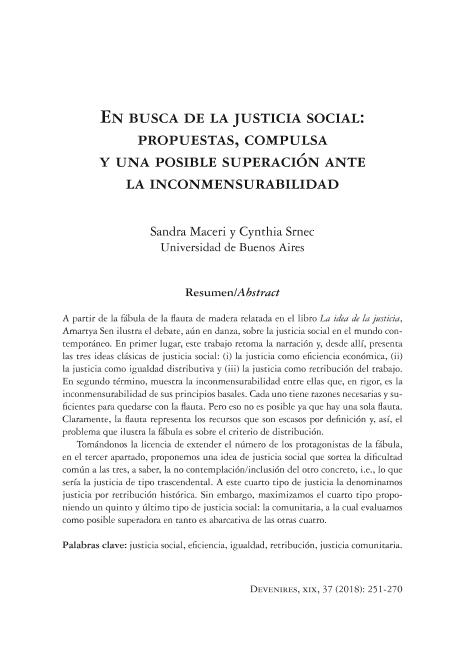Artículo
A partir de la fábula de la flauta de madera relatada en el libro La idea de la justicia, Amartya Sen ilustra el debate, aún en danza, sobre la justicia social en el mundo contemporáneo. En primer lugar, este trabajo retoma la narración y, desde allí, presenta las tres ideas clásicas de justicia social: (i) la justicia como eficiencia económica, (ii) la justicia como igualdad distributiva y (iii) la justicia como retribución del trabajo. En segundo término, muestra la inconmensurabilidad entre ellas que, en rigor, es la inconmensurabilidad de sus principios basales. Cada uno tiene razones necesarias y suficientes para quedarse con la flauta. Pero eso no es posible ya que hay una sola flauta. Claramente, la flauta representa los recursos que son escasos por definición y, así, el problema que ilustra la fábula es sobre el criterio de distribución. Tomándonos la licencia de extender el número de los protagonistas de la fábula, en el tercer apartado, proponemos una idea de justicia social que sortea la dificultad común a las tres, a saber, la no contemplación/inclusión del otro concreto, i.e., lo que sería la justicia de tipo trascendental. A este cuarto tipo de justicia la denominamos justicia por retribución histórica. Sin embargo, maximizamos el cuarto tipo proponiendo un quinto y último tipo de justicia social: la comunitaria, a la cual evaluamos como posible superadora en tanto es abarcativa de las otras cuatro. From the fable of the wooden flute related in the book The Idea of Justice, Amartya Sen illustrates the still in course debate, about social justice in the contemporary world. In the first place this article refers to the main issue from the fable and, from there, presents the three classic ideas of social justice: (i) justice as economic efficiency, (ii) justice as distributive equality and (iii) justice as compensation for work. In the second place, it shows the incommensurability between them that, specifically, is the incommensurability of their basal principles. Each of the three children from the fable has the reasons enough to keep the flute. But, since there is only one flute, that cannot be possible. Clearly, the flute represents the resources that are scarce by definition and, thus, the problem that illustrates the fable is about the distribution criteria. Taking the license to extend the protagonists of the fable, in the third section, we propose a fourth idea of social justice that eludes the common difficulty of the original three, specifically, the non-contemplation of the concrete other, not transcendental, that we designated as justice for historical retribution. However, we maximize the fourth type by proposing a fifth and last type of social justice: the community type, which we evaluate as a possible overcoming as it encompasses the other four.
En busca de la justicia social: propuestas, compulsa y una posible superación ante la inconmensurabilidad
Título:
In search of social justice: proposals, confrontation and a possible overcoming in the
face of incommensurability
Fecha de publicación:
06/2018
Editorial:
Universidad Michoacana de San Nicolás de Hidalgo. Facultad de Filosofía “Dr. Samuel Ramos Magaña”
Revista:
Devenires
ISSN:
1665-3319
e-ISSN:
2395-9274
Idioma:
Español
Tipo de recurso:
Artículo publicado
Clasificación temática:
Resumen
Palabras clave:
JUSTICIA SOCIAL
,
EFICIENCIA
,
IGUALDAD
,
RETRIBUCIÓN
,
JUSTICIA COMUNITARIA
Archivos asociados
Licencia
Identificadores
Colecciones
Articulos(IIEP)
Articulos de INST. INTER. DE ECONOMIA POLITICA DE BUENOS AIRES
Articulos de INST. INTER. DE ECONOMIA POLITICA DE BUENOS AIRES
Citación
Maceri, Sandra Beatriz; Srnec, Cynthia Cecilia; En busca de la justicia social: propuestas, compulsa y una posible superación ante la inconmensurabilidad; Universidad Michoacana de San Nicolás de Hidalgo. Facultad de Filosofía “Dr. Samuel Ramos Magaña”; Devenires; XIX; 37; 6-2018; 251-270
Compartir




